The global cross-docking services industry stood at a $200 billion valuation in 2020. It is expected to reach a $342 valuation by 2030. Many industries employ cross-docking logistics in their supply chain. The biggest end-users of cross-docking services include:
- Ecommerce and Retail
- Healthcare and Pharmaceuticals
- Food and Beverages
- Automotive Industry
- Defence and Aerospace
- Manufacturing
The cross-docking strategy can help companies reduce logistics costs. It can also help accelerate the movement of goods through the supply chain. That is why many companies are using the cross-docking method.
In this article, we will understand the cross-docking process. We will also see how you can implement this strategy in your supply chain.
What is Cross-Docking?
Cross-docking is a logistics distribution strategy. This strategy involves transporting goods with little to no handling or storage. The cross-docking process involves three stages:
1. Receiving Inventory from Inbound Vehicles
2. Handling
3. Dispatching Inventory with Outbound Vehicle
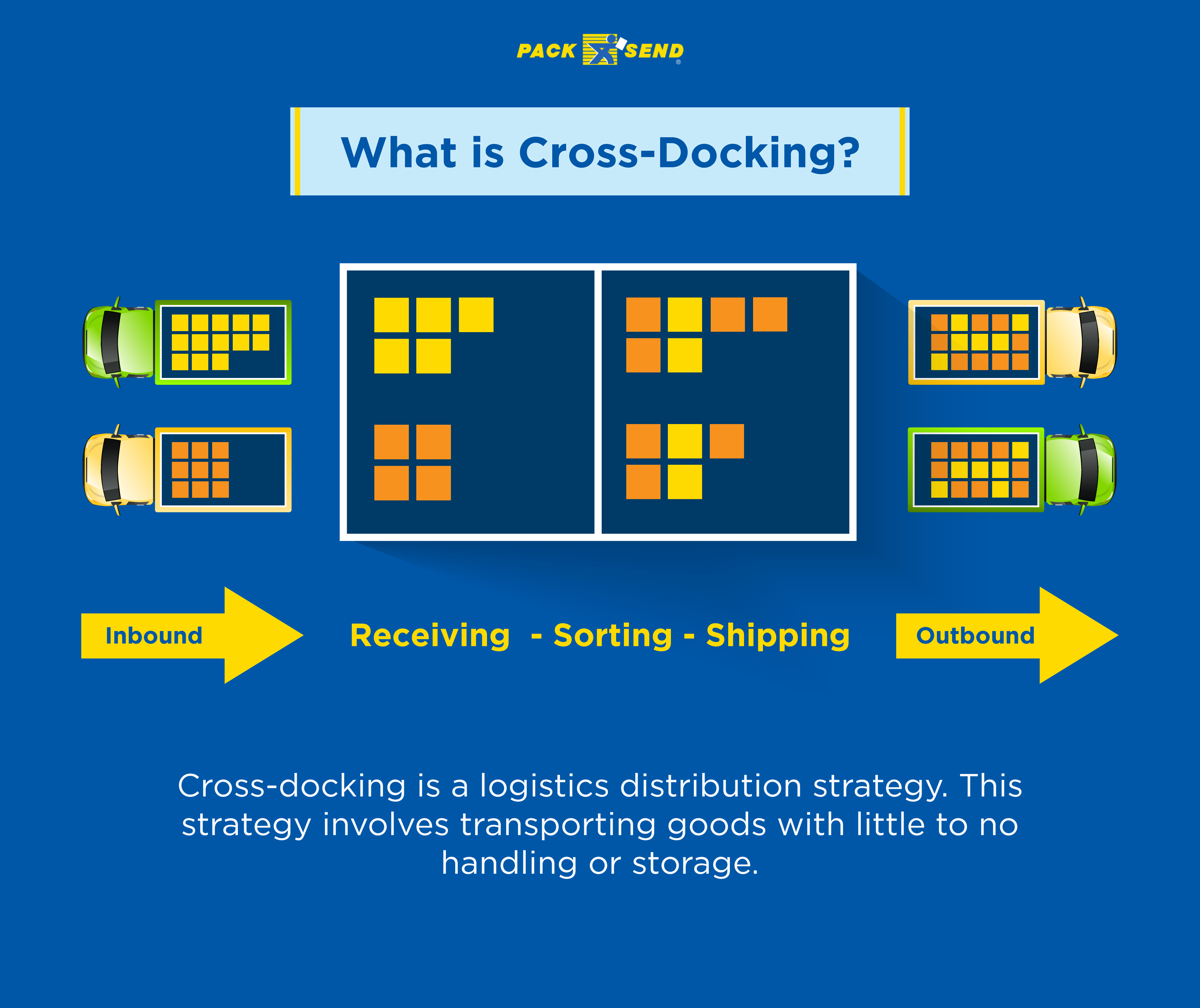
Companies use cross-docking in supply chain management to transport goods directly to points of consumption. Cross-docking logistics is commonly used for following transportation cycles in a supply chain:
1. Supplier to Manufacturer
2. Supplier to Retail Outlet
3. Manufacturer to Retail Outlet
4. Manufacturer to Customer
5. Supplier to Customer
For example, a road freight arrives at the distribution centre. The distribution centre unloads and sorts the inventory. They load the sorted inventory into Less Than Truckload (LTL) vehicles. The LTL vehicles supply the inventory to different retail outlets.
A key aspect of cross-dock shipment is that you do not store the goods between transportation cycles. You unload the goods from one vehicle. Then you load them onto another vehicle. However, you may have to unpack, sort, consolidate, or repackage the goods between these stages.
The cross-docking logistics create an unbroken supply line. It also eliminates the need for storage. This enables faster movement of goods. The cross-docking method is often used to accelerate fulfilment. But, it can only be used for goods that do not require storage or customisations.
There are several different types of cross-docking methods. Let’s see how you can utilise these in your supply chain.
Types of Cross Docking
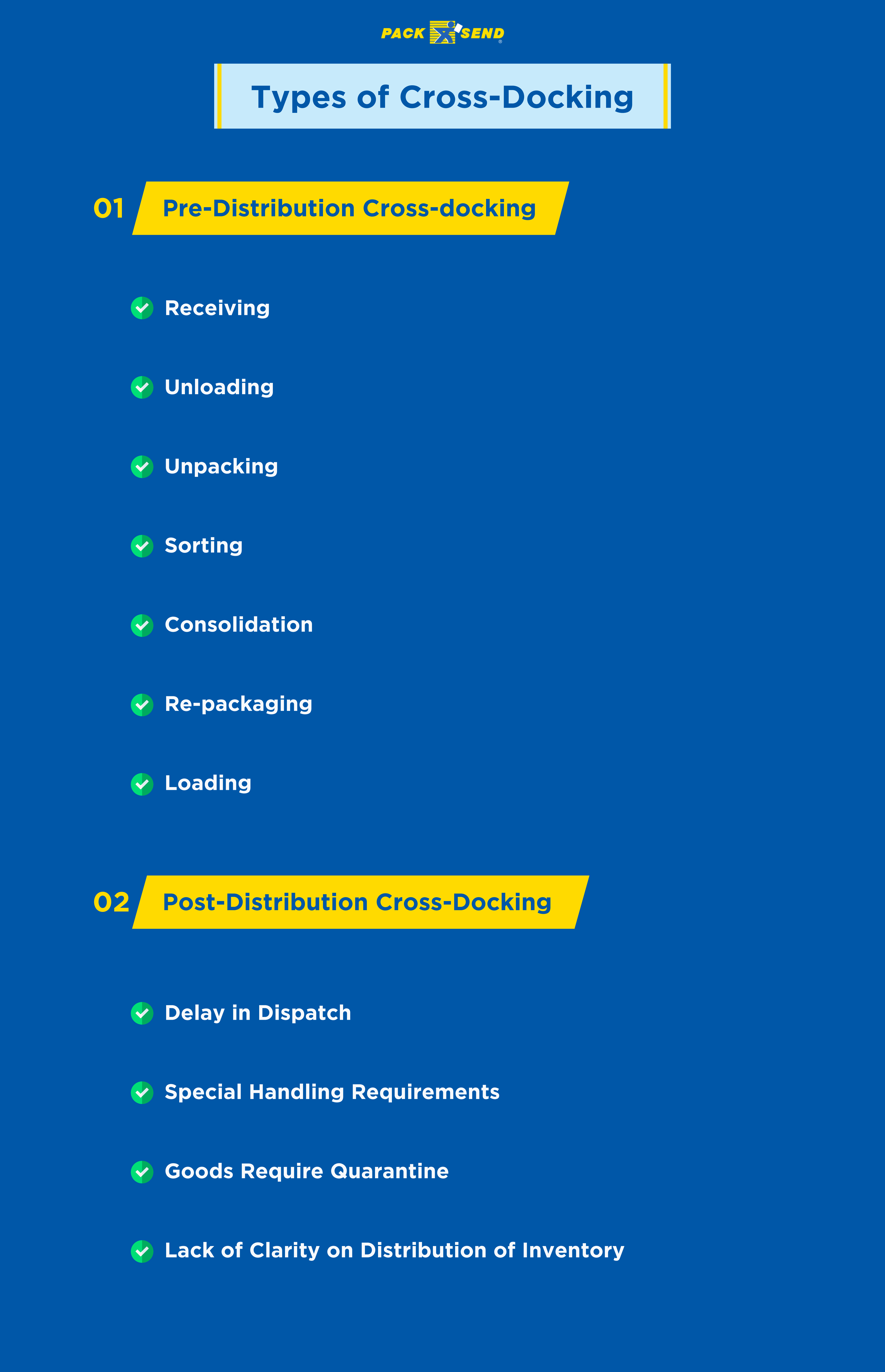
The types of cross-docking logistics depend on how you use the cross-docking terminal. This terminal can be a warehouse or a distribution centre. Based on this, there are two types of cross-docking processes:
1. Pre-Distribution Cross-docking
2. Post-Distribution Cross-docking
Pre-Distribution Cross Docking
In this cross-docking method, you do not store the goods. The goods are exchanged between two vehicles without warehousing. But, it does involve handling. This type of cross-docking usually works on pre-defined instructions. The pre-distribution cross-docking process involves:
1. Receiving
2. Unloading
3. Unpacking
4. Sorting
5. Consolidation
6. Re-packaging
7. Loading
You would carry out these steps at a cross-docking terminal. The inbound vehicle is quickly unloaded. The cross-docking terminal carries out pre-defined handling procedures. The inventory is loaded onto outbound vehicles. The outbound vehicle is dispatched for delivery.
You only have to hold the inventory for handling procedures. In some cases, there are no handling requirements. You only need to unload the inbound vehicle. Then load and dispatch the outbound vehicle.
Post-Distribution Cross-Docking
In this type of cross-docking, you store the inventory before dispatch. The storage duration is short. The inventory is only held until the next dispatch. The need for storage can stem from several reasons. Some of the most common reasons to hold goods at a cross-docking warehouse include:
1. Delay in Dispatch
2. Special Handling Requirements
3. Goods Require Quarantine
4. Lack of Clarity on Distribution of Inventory
This type of cross-docking logistics is often pre-planned. But, you can also employ it to compensate for supply chain blockages. For instance, if the retailer cannot receive scheduled delivery. You can store the merchandise at the cross-docking warehouse. You can also redirect the flow of inventory to other retailers. Both of these tactics require time. So you hold the stock at the cross-docking warehouse.
You can also use this strategy if you need time to figure out the inventory requirements in different locations. You can receive the inventory at the cross-docking terminal. Then dispatch the inventory based on the demand.
The storage time in this type of cross-docking is often shorter than in traditional warehousing. You only store the inventory until dispatch. A cross-docking warehouse is not used for stock goods.
What is a Cross-Dock Warehouse?
A cross-dock warehouse is a storage and handling facility. It is also known as a cross-docking terminal. This facility serves as a station for cross-docking logistics. It receives inventory from inbound vehicles. The personnel at this facility unload, unpack, sort, consolidate, and re-package goods. Then they load the goods on outbound vehicles.
The cross-dock warehouse also serves as a temporary storage facility. Inventory is stored at a cross-docking terminal in the post-distribution method.
What is the Difference Between Cross Docking and Traditional Warehousing?
The key difference between cross-docking and traditional warehousing is the purpose of storage. In traditional warehousing, the goods are stocked at a warehouse. In the cross-docking strategy, goods are only temporarily stored.
The duration of storage is longer in traditional warehousing. Whereas goods are only stored until dispatch in cross-docking logistics.
The size of storage facilities is also different in both. Traditional warehousing often uses large storage facilities. The cross-docking process only requires limited storage space. A traditional warehouse is optimised for inventory management and fulfilment. While cross-docking warehouse is optimised for fast exchange of goods.
A cross-dock warehouse serves more as a distribution centre than a storage unit. It receives goods from one source. Then it distributes the goods to other locations.
What is the Process of Cross-Docking?
On the surface, the cross-docking process is simple. You receive goods. You sort them. And you ship them. However, it is a complex phenomenon in practice.
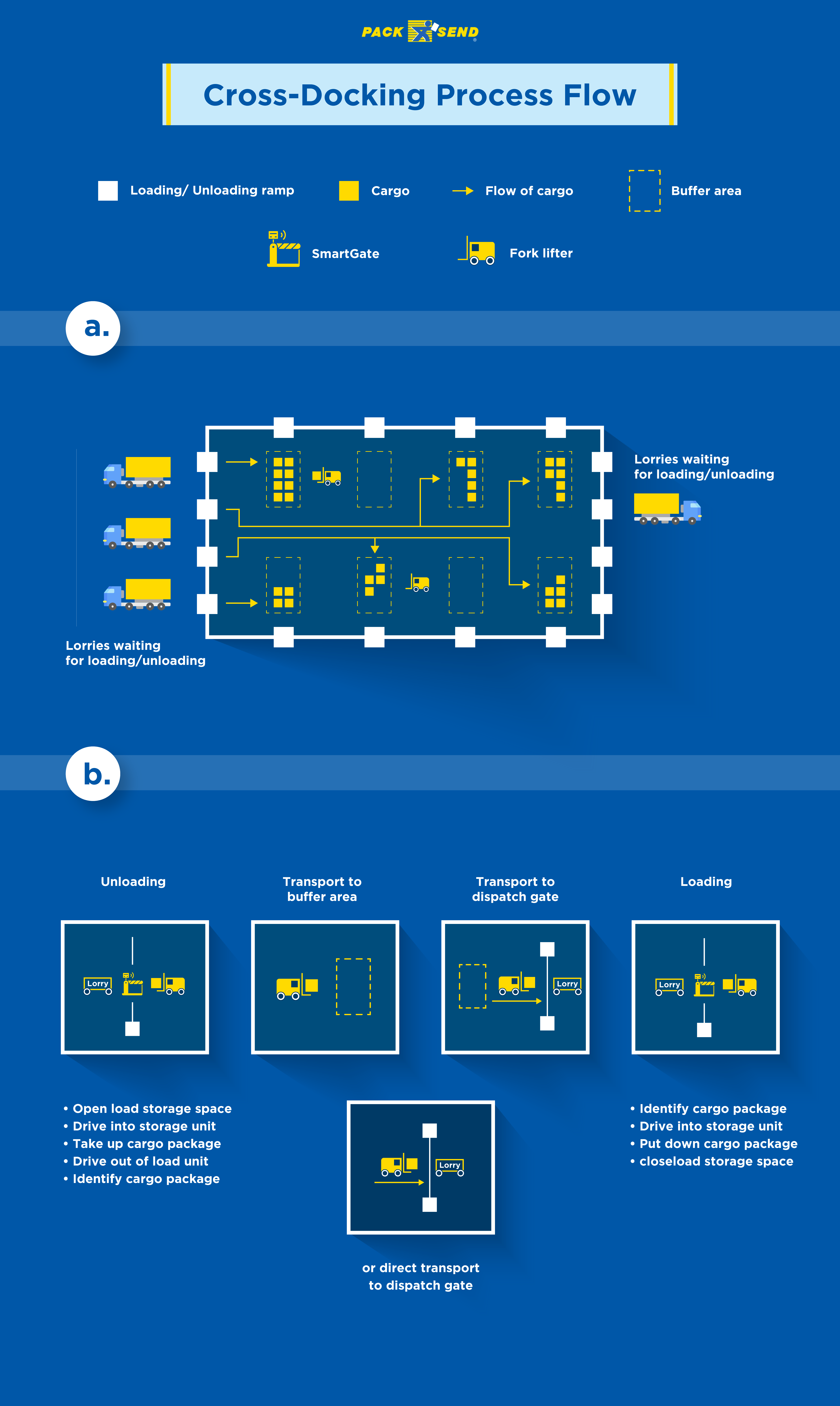
Cross-docking logistics involves three stages:
1. Receiving
2. Handling
3. Dispatch
Each stage may involve several processes. The stages of the cross-docking process follow a linear sequence. The steps in each stage depend on the overall cross-docking strategy.
Let’s understand the steps at each stage:
Receiving
The first stage of the cross-docking process is receiving inventory. A cross-dock warehouse can receive inventory from several sources. These include suppliers, manufacturers, and other warehouses. This stage involves the following steps:
1. Docking inbound vehicles.
2. Unloading the inventory from the vehicle.
3. Checking & processing the inventory for handling.
The receiving process may vary depending on the type of cross-docking method. If the goods do not require any type of handling, you can directly process the inventory for dispatch.
Handling
The handling stage in the cross-docking strategy has the most variables. It is quite similar to traditional warehouse management. These steps at this stage can change depending on the purpose of cross-dock shipment.
The handling stage involves:
1. Cataloging received inventory.
2. Unpacking the received goods.
3. Sorting goods.
4. Storing inventory for distribution.
5. Organising inventory in storage.
6. Picking goods for dispatch.
7. Consolidating goods for dispatch.
8. Re-packaging goods for fulfilment.
9. Delivering goods at the dispatch gate.
The handling stage may involve some or all of the above steps. It depends on the role of cross-docking in supply chain management.
For instance, if you are drop-shipping goods from multiple suppliers. Then your handling stage may involve sorting, consolidating, and repackaging. But, if you are using the pre-distribution cross-docking method. Then you may skip steps like storage, consolidation, and repackaging.
The steps at the handling stage can serve different purposes.
For example, you may require repackaging after consolidating goods. You may also require repackaging for blind shipping. While you employ the same step for both scenarios of cross-dock shipment. But, they serve different purposes.
The handling stage also involves storage and inventory management. Although temporary, these are crucial for cross-docking logistics. It ensures visibility and control over the movement of goods.
Dispatch
This is the final stage of the cross-docking method. Here you supply the handled inventory to one or more destinations using outbound vehicles. The steps at this stage of cross-docking in supply chain management involve:
1. Checking and processing outbound inventory
2. Allocating inventory to different outbound vehicles
3. Defining dispatch schedule for outbound vehicles
4. Loading outbound vehicles with the inventory
5. Dispatching outbound vehicles for fulfilment
The steps at the dispatch stage are constant in all types of cross docking. A cross-dock terminal typically handles several dispatches a day. Hence, speed and efficiency are critical at this stage.
The stages may vary a little in different types of cross-docking strategies. Let’s see how these strategies change the cross-docking process.
Cross-Docking Strategies
Cross-docking strategy changes from business to business. Cross-docking in supply chain management depends on several factors. These include fulfilment strategy, sources of supply, types of goods, fulfilment destinations, etc.
Let’s look at some of the most widely used cross-docking strategies.
Continuous Cross-Docking
In this strategy, there is a constant flow of inbound and outbound inventory. The inventory keeps moving in and out of the cross-dock terminal. It is a form of pre-distribution type of cross-docking.
You can implement this strategy if you have minimum handling requirements. The primary handling function in this strategy is sorting. You will sort the received inventory into different pallets. Then you designate each pallet to an outbound vehicle.
You also need clearly defined distribution guidelines to implement this cross-docking method. As handling and storage are minimal. The waiting period between inbound and outbound inventory is short.
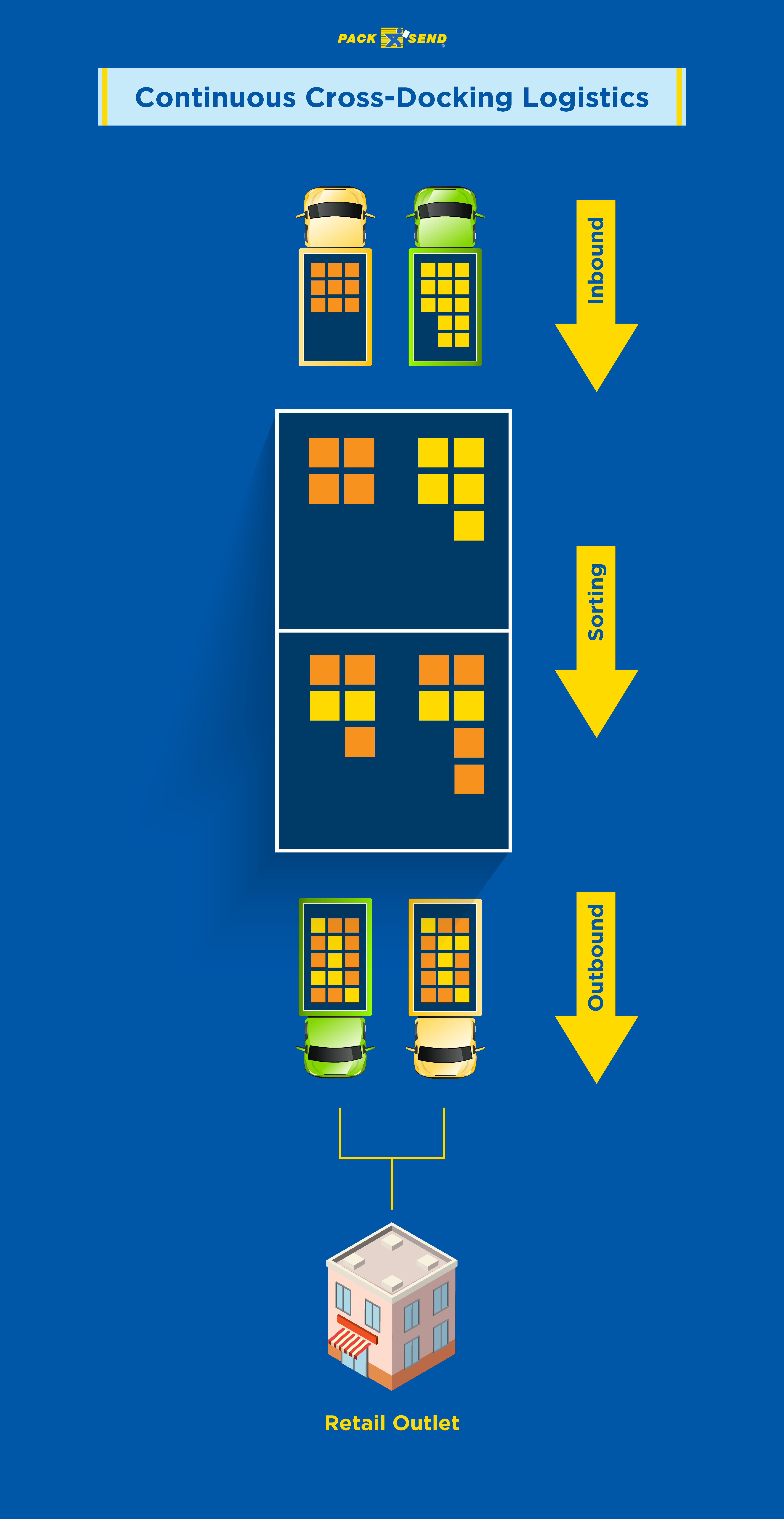
Continuous cross-docking logistics is commonly used in the F&B industry. It’s an ideal way to transport perishable goods. This strategy also helps with distribution logistics. You can receive large inventory from the suppliers. Then you use cross-docking logistics to supply inventory to different fulfilment centres.
It is a fast tactic for distributing cross-dock shipments. But, it heavily relies on efficiency. You need accuracy in sorting and loading inventory in different vehicles. You also need clear communication.
This cross-docking process draws from pre-defined instructions. These instructions guide sorting, loading, and dispatching. If the information is inaccurate, it can block the flow of continuous cross-docking in the supply chain.
Consolidation Cross-Docking
In this cross-docking strategy, the primary handling function is consolidation. You receive inventory from different sources. Then you sort and consolidate the inventory into pallets. The consolidated pallets are designated for different outbound vehicles. It is a form of post-distribution type of cross-docking.
This strategy has significant handling requirements. Hence, the storage time is a little longer than the continuous cross-docking method. The cross-dock terminal also has to manage various inbound and outbound schedules.
For instance, the inbound vehicles may arrive at different times. So you must wait until the last truckload to move the cross-docking process forward.
You need efficient inventory management for this cross-docking strategy. You need to consolidate the received inventory in pallets for outbound vehicles accurately. Each pallet may require a different quantity from the received goods.
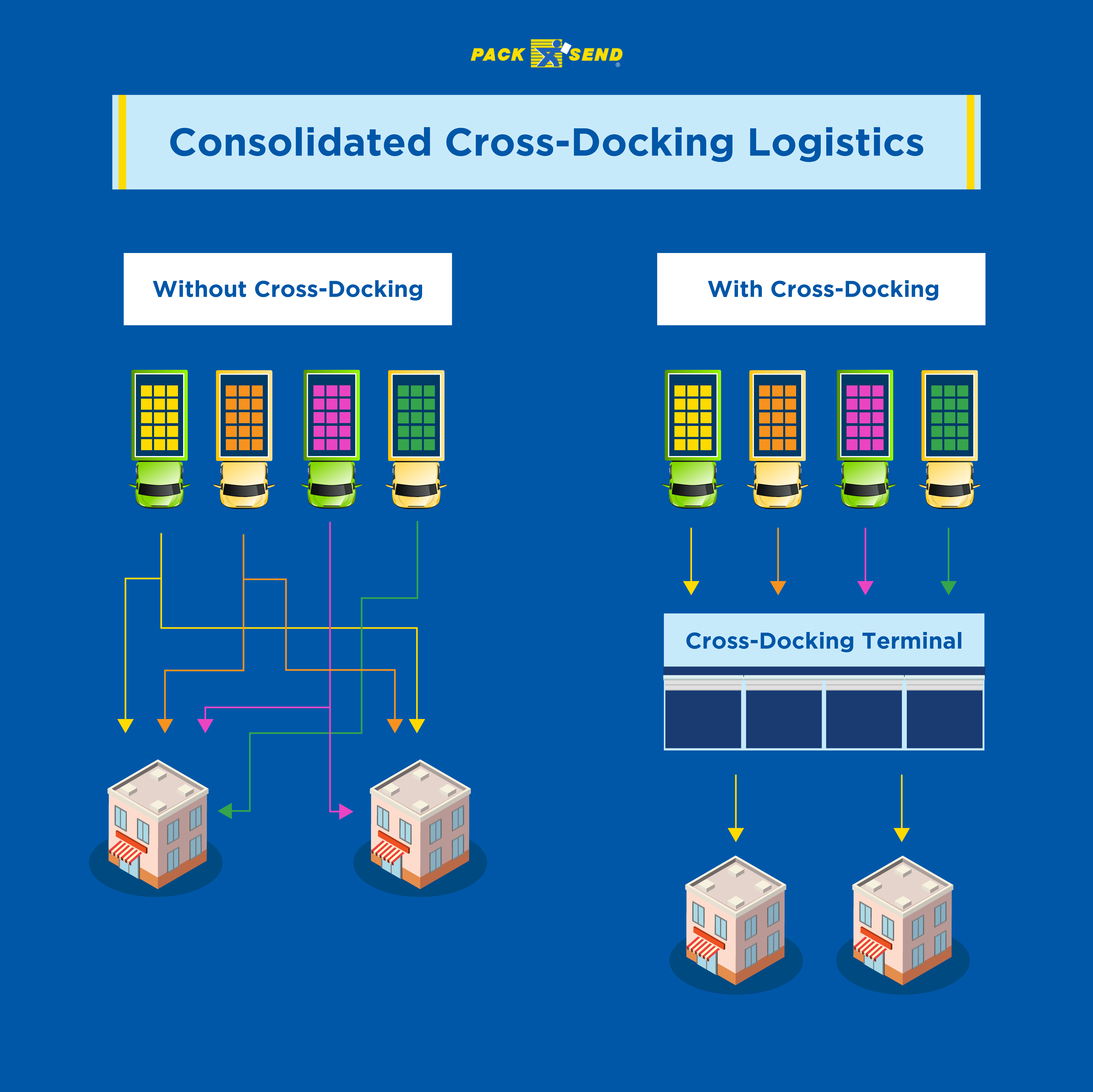
This type of cross-docking method is commonly used for retail fulfilment. It is employed when there are several sources of supply. And each source supplies different products. Shipping products directly to retail outlets from each source can be expensive.
So, retailers can use a consolidation cross-docking strategy to stock the outlets. The retailer can use fewer and larger vehicles to manage their supply chain. This can significantly reduce the cost of fulfilment.
De-consolidation Cross-Docking
In this cross-docking strategy, you receive inventory from one source. Then you distribute it into smaller fragments. These fragments then go on different outbound vehicles. Each outbound vehicle supplies the inventory to different destinations. This is basically the opposite of the consolidation cross-docking strategy.
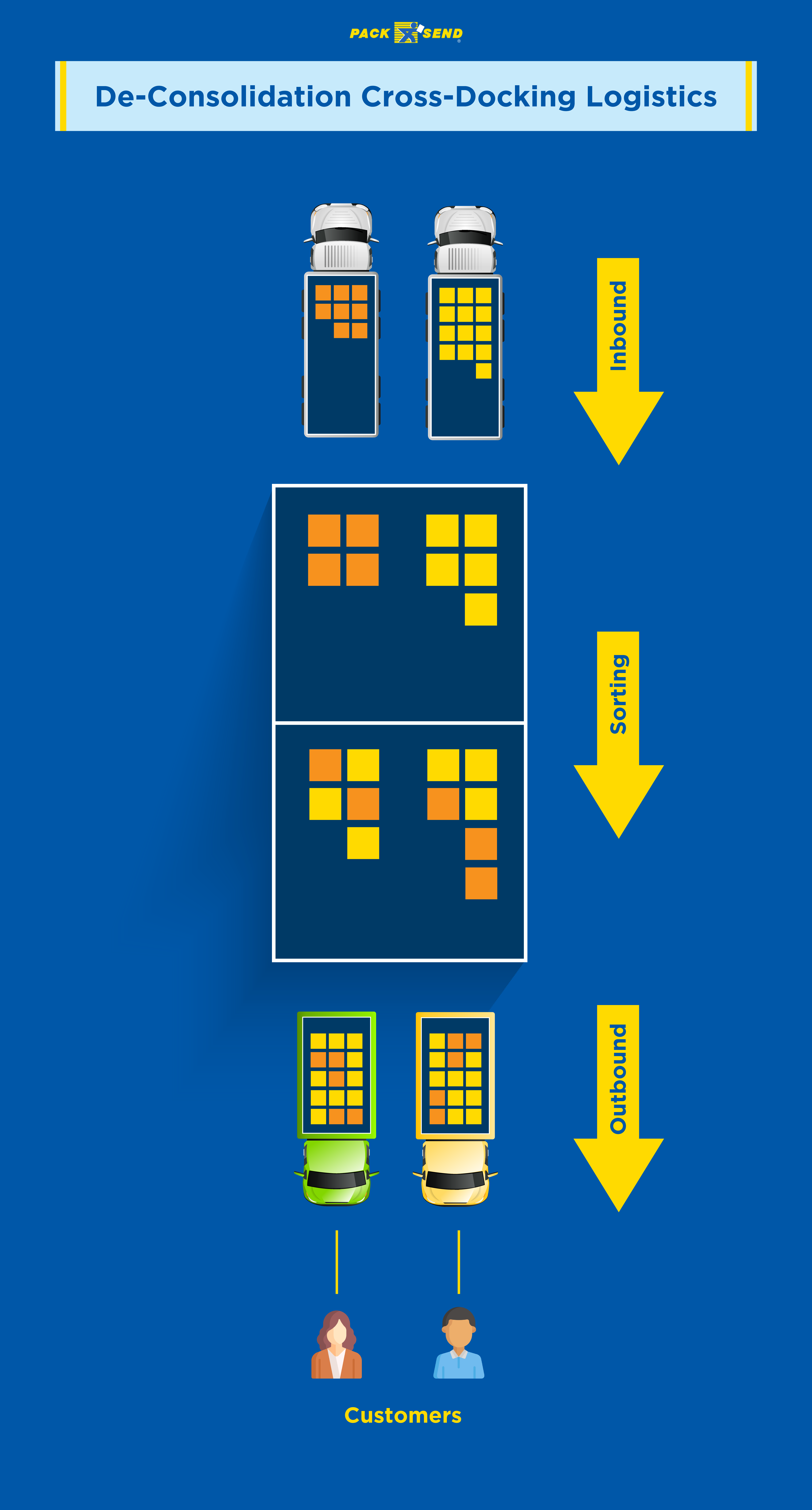
The primary handling function in this method is sorting. It may also involve unpacking and repacking. You might also store the inventory temporarily. The storage duration is often short. The inventory is only stored until dispatch.
In this strategy, there are more outbound vehicles than inbound. The inbound vehicles are often larger road freights. Outbound vehicles are often smaller. These include LTL, small trucks, or cargo vans.
The purpose of de-consolidation cross-docking logistics is to distribute inventory. It is commonly used to stock retail outlets and micro-fulfilment centres. You can also employ this cross-docking strategy for eCommerce order fulfilment.
In this cross-docking method, the terminal acts as a distribution centre. You take supplies in bulk from a supplier or manufacturer. Then you distribute the inventory in small fragments to various points of consumption.
When Cross-Docking can be Used?
You can use cross-docking in several logistics distribution models. This method is effective for retail and wholesale distribution, eCommerce order fulfilment, micro-fulfilment, supply management, drop shipping, blind shipping, and more. You can divide the use of cross-docking logistics into three categories:
1. One Source to Many Destinations
2. Many Sources to One Destination
3. Many Sources to Many Destinations
These types of cross-docking methods are based on the number of sources and destinations. A cross-docking warehouse acts as a mediator between sources and destinations. Let’s understand how you can use cross-docking in each of these scenarios.
One Source to Many Destinations
You receive inbound inventory from one source. Then you supply the inventory to many destinations.

For example, you want to supply inventory to many retail stores. You receive inventory from the manufacturer in bulk. You would receive the bulk inventory through road freight. Then you sort the inventory during the cross-docking process. You divide the bulk inventory into segments for different retail stores. You would use smaller vehicles to supply each segment to a retail store.
You can use the same cross-docking method for eCommerce order fulfilment as well. You would receive inventory from the supplier. Then you can use the cross-dock terminal as a fulfilment centre. The inbound inventory would be delivered by freight. While the outbound inventory will reach the customers through last-mile delivery vehicles.
Many Sources to One Destination
You receive inbound inventory from several sources. These could be suppliers or manufacturers. You then consolidate the inventory from different sources to create a single cross-dock shipment. Then you supply the consolidated shipment to a single destination.
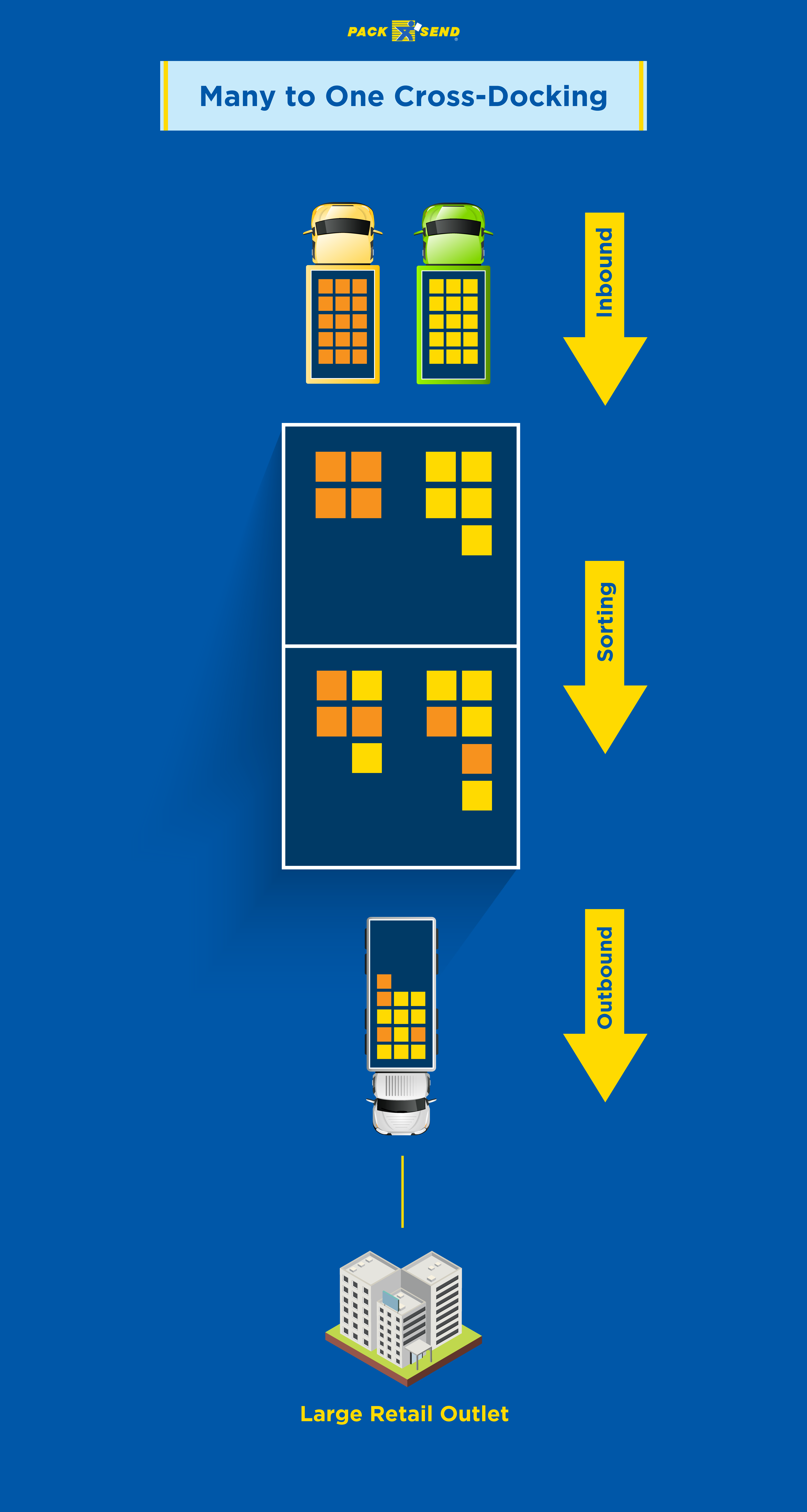
This cross-docking strategy can work effectively for omnichannel retailing. You can also use it for drop shipping and blind shipping.
For example, you want blind ship products from different manufacturers to several customers. You can receive different SKUs at the cross-docking warehouse. You can sort and consolidate products based on the orders. Then you can repackage or relabel the cross-docking shipment. So the outbound vehicles will carry couriers with blind-shipping labels.
You can use the cross-docking process to sort, consolidate, and repackage products. Then you can use the same facility for fulfilment. This can help you cut down the cost of warehousing and shipping. It can also help you accelerate the order fulfilment process.
What are the Benefits of Cross-Docking?
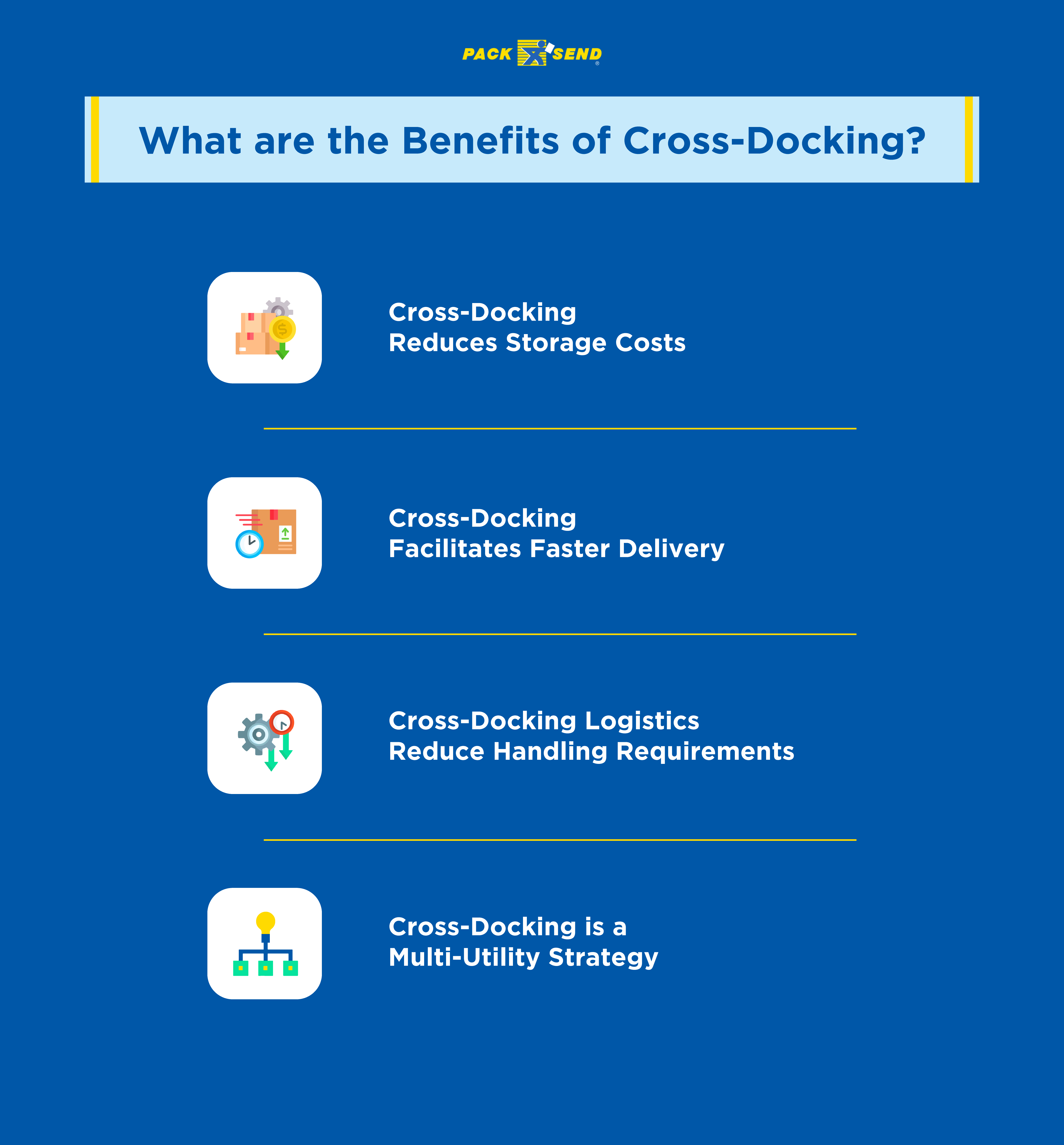
Cross-docking is a lean distribution strategy. There are several benefits of cross-docking in supply chain management. If done efficiently, it can distribute inventory with minimal resources. Here are the major benefits of cross-docking:
Cross-Docking Reduces Storage Costs
The most obvious benefit of cross-docking is that it reduces storage costs. Instead of using a large warehouse, you use a cross-docking terminal. You only have to store the inventory for a short period. All the supplied inventory is dispatched ahead in the supply chain.
You not only save on the cost of warehousing. You also save money on expenses on several heads. These include labour, equipment, inventory management, and so on. Considering the rising price of warehousing, cross-docking in supply chain management can be an efficient cost-saving tactic.
Cross-Docking Facilitates Faster Delivery
Cross-docking strategy functions on speed and efficiency. All supplied goods are dispatched without spending time in storage. A cross-docking warehouse is also smaller than traditional warehouses.
The majority of inventory is dispatched. So cross-docking logistics also deals with less inventory in a time frame. Furthermore, cross-docking terminals have to carry out fewer tasks compared to a warehouse. All these factors combine to create a fast fulfilment system. The entire facility is optimised to move inventory from inbound to outbound.
Cross-Docking Logistics Reduce Handling Requirements
Material handling in cross-docking is lower than in traditional warehousing. You also deal with less volume in a given time. Cross-docking method reduces the need for tracking inventory movement. You also have to manage fewer SKUs at any given time.
This significantly reduces handling requirements. The inventory moves faster through the cross-docking process. As a result, you get a high inventory turnover rate. Certain industries such as F&B benefit from cross-docking strategy. Less handling reduces the possibility of damaging such products.
Cross-docking in supply chain management is also suitable for products with limited shelf life. These include cosmetics, pharmaceuticals, food products, etc. These products need fast movement through the supply chain with minimum handling. A cross-dock shipment moves rapidly through the supply chain. This gives added shelf life to the end consumer.
Cross-Docking is a Multi-Utility Strategy
A cross-docking warehouse can serve several purposes. It can function as a distribution centre, temporary storage facility, sorting facility, and fulfilment centre. A cross-dock terminal can help you move products through the supply chain. It can also help you sort and consolidate products for distribution.
You can use cross-docking logistics to run the entire distribution channel. And you can combine cross-docking in supply chain management with other logistics distribution strategies. These include traditional warehousing, micro-fulfilment, and drop-shipping. You can also use different types of cross-docking methods at different stages of the supply chain.
Use the Cross-Docking Network of a 3PL
Cross-docking is an effective logistics distribution strategy. It can help you manage supply chain operations without using a storage facility. Cross-docking logistics is also faster than traditional warehousing. But, you need an efficient cross-docking terminal to execute this strategy.
You also need to manage inbound and outbound cross-dock shipments. Each cross-dock warehouse requires a significant investment. You would also need to invest in freight and delivery vehicles.
A single cross-dock terminal can only handle limited supply cycles. So you will need to expand the size or add more terminals to your supply chain. This can slow you down while scaling operations.
But, you can still benefit from the speed and efficiency of cross-docking without any investment. For this, you can hire a 3PL logistics company, like PACK & SEND.
You can use their existing logistics resources and a widespread network for courier delivery. Your logistics partner can use cross-docking and other logistics strategies to fulfil your supply chain requirements.
Image sources: Creative Safety Supply, ResearchGate, Red Stag Fulfillment, RTD Logistics
